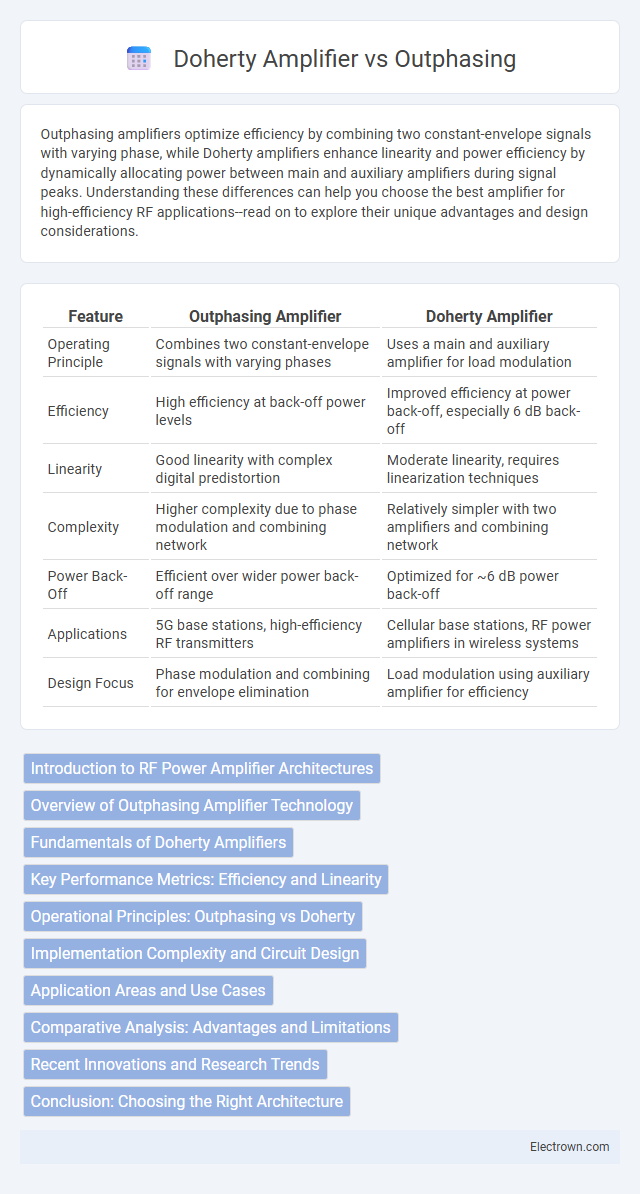Outphasing amplifiers optimize efficiency by combining two constant-envelope signals with varying phase, while Doherty amplifiers enhance linearity and power efficiency by dynamically allocating power between main and auxiliary amplifiers during signal peaks. Understanding these differences can help you choose the best amplifier for high-efficiency RF applications--read on to explore their unique advantages and design considerations.
Table of Comparison
| Feature | Outphasing Amplifier | Doherty Amplifier |
|---|---|---|
| Operating Principle | Combines two constant-envelope signals with varying phases | Uses a main and auxiliary amplifier for load modulation |
| Efficiency | High efficiency at back-off power levels | Improved efficiency at power back-off, especially 6 dB back-off |
| Linearity | Good linearity with complex digital predistortion | Moderate linearity, requires linearization techniques |
| Complexity | Higher complexity due to phase modulation and combining network | Relatively simpler with two amplifiers and combining network |
| Power Back-Off | Efficient over wider power back-off range | Optimized for ~6 dB power back-off |
| Applications | 5G base stations, high-efficiency RF transmitters | Cellular base stations, RF power amplifiers in wireless systems |
| Design Focus | Phase modulation and combining for envelope elimination | Load modulation using auxiliary amplifier for efficiency |
Introduction to RF Power Amplifier Architectures
RF power amplifier architectures such as Outphasing and Doherty play crucial roles in enhancing transmitter efficiency and linearity in modern wireless communication systems. The Outphasing amplifier combines two constant-envelope signals with varying phase to control output power, optimizing efficiency at back-off levels. The Doherty amplifier utilizes a main and auxiliary amplifier to dynamically adjust power delivery, significantly improving efficiency in signals with high peak-to-average power ratios.
Overview of Outphasing Amplifier Technology
Outphasing amplifier technology combines two constant-envelope signals with varying phase difference to achieve high efficiency in RF power amplification. By modulating the phase of two amplifiers operating in class B or C, Outphasing effectively controls output power while reducing linearity distortion without requiring a traditional supply voltage variation. This approach is particularly beneficial for wireless communication systems where energy efficiency and signal fidelity are critical.
Fundamentals of Doherty Amplifiers
Doherty amplifiers utilize a main amplifier and a peaking amplifier working in tandem to improve efficiency at back-off power levels by dynamically sharing the load. The design relies on impedance modulation to maintain linearity and reduce power dissipation, enabling better performance in wireless communication systems. Understanding these fundamentals helps you optimize amplifier performance for applications requiring high efficiency and linearity.
Key Performance Metrics: Efficiency and Linearity
Outphasing and Doherty amplifiers both optimize RF power efficiency, with Doherty designs typically achieving higher efficiency at back-off power levels through complementary active devices. Outphasing amplifiers excel in linearity by combining two constant-envelope signals with phase modulation, reducing distortion in wideband applications. Efficiency in Doherty circuits peaks near saturation, while Outphasing maintains consistent linearity, making each suited for different trade-offs in wireless communication systems.
Operational Principles: Outphasing vs Doherty
Outphasing amplifiers operate by splitting the input signal into two constant-envelope signals, which are then phase-shifted and recombined to achieve amplitude modulation, enhancing efficiency in power amplification. Doherty amplifiers utilize a main and auxiliary amplifier working in tandem, where the auxiliary amplifier activates during high power peaks to improve linearity and efficiency by dynamically sharing the load. Your choice between these depends on whether your application prioritizes efficiency through phase modulation or dynamic load sharing for power scaling.
Implementation Complexity and Circuit Design
Outphasing amplifiers require complex phase modulation and precise load modulation networks, increasing implementation difficulty compared to Doherty amplifiers, which utilize a simpler load modulation scheme with active main and auxiliary amplifiers. Doherty amplifier designs are more straightforward due to their use of impedance inverters and quarter-wave transformers, facilitating efficient power combining and linearity enhancement with fewer control parameters. Outphasing circuits demand intricate phase shifters and combining networks, making them more challenging for integration in compact, high-frequency applications.
Application Areas and Use Cases
Outphasing amplifiers are widely used in wireless communication systems such as base stations for 4G and 5G networks, where efficiency and linearity are critical for handling complex modulation schemes. Doherty amplifiers excel in broadcast transmitters and satellite communication due to their high efficiency at backed-off power levels, making them ideal for applications with variable envelope signals. Both amplifier types are essential in modern RF power amplification, with outphasing favored for broadband signals and Doherty preferred for high-efficiency narrowband applications.
Comparative Analysis: Advantages and Limitations
Outphasing amplifiers offer high efficiency by combining two constant-envelope signals with varying phase, reducing power dissipation but often suffer from increased complexity and signal distortion at high bandwidths. Doherty amplifiers excel in improving efficiency at back-off power levels, making them suitable for modern communication systems with fluctuating signals, yet they are limited by narrow bandwidth and design complexity. The trade-off between Outphasing's linearity and broader bandwidth potential versus Doherty's superior back-off efficiency highlights key considerations in amplifier selection based on application-specific power and linearity requirements.
Recent Innovations and Research Trends
Recent innovations in Outphasing amplifiers have focused on enhancing linearity through digital predistortion and adaptive control techniques, improving efficiency in 5G and beyond wireless systems. Doherty amplifiers are incorporating GaN (Gallium Nitride) technology and advanced load modulation methods to achieve higher power density and broader bandwidth for modern communication standards. Your choice between these architectures should consider the latest research trends emphasizing energy efficiency and signal fidelity in high-frequency applications.
Conclusion: Choosing the Right Architecture
Outphasing and Doherty amplifiers offer distinct advantages in power efficiency and linearity, making your choice highly dependent on the specific application requirements. Outphasing provides superior efficiency at back-off power levels, ideal for modern communication systems with high peak-to-average power ratios. Doherty amplifiers excel in improving efficiency in load-modulated scenarios, often favored for base station transmitters requiring robust performance and scalability.
Outphasing vs Doherty Amplifier Infographic

 electrown.com
electrown.com